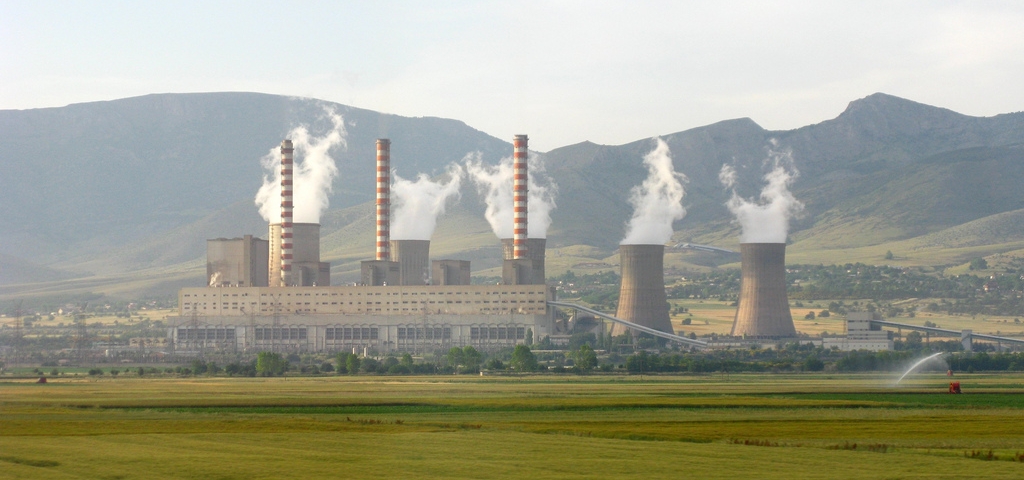The Greek energy system is still relaying to a large extent on lignite power plants. Apart from the known negative impacts on public health, an increasing number of proposed projects will have a negative return on investment. Tasos Krommydas reports.

Lignite power plants are expensive to operate and to construct, as well as hazardous to health. Despite that, new lignite power plants are being constructed in Greece. (Photo by Tilemahos Efthimiadis, modified, CC BY-NC-ND 2.0)
The dominant mantra in the public discourse in Greece is that lignite is the only domestic energy source, an argument that has gathered increased significance in the context of the economic crisis of the past six years. Indeed, Greece has (2013) an energy dependency rate of 62.1% (compared to an average 53.2% for the EU-28) importing 100% of the natural gas and 98% of the oil it consumes.
In terms of lignite production, Greece ranks seventh worldwide and third in the EU (after Germany and Poland). Based on the total exploitable lignite reserves in the country and the planned future consumption rate, it is estimated that reserves could last for more than 45 years.
It is relatively recent that the general public has started to become aware of the negative externalities associated with lignite extraction and combustion. With regard to public health, even though no major epidemiological study has ever been commissioned, individual localized studies have demonstrated an increase in the death rate from thromboembolic events and a higher likelihood of allergic rhinitis in the lignite processing regions. According to data and methodologies employed by the European Environment Agency, air pollution due to the operation of lignite-fired plants led to 461 premature deaths in 2009. Another considerable negative aspect of the lignite extracting activities is the forced relocation of several villages. From 1972 to 2003, almost 4,000 inhabitants were resettled, after five villages were swallowed up by the mine extensions. At present, the relocation of an additional four villages is either underway or has been decided.
A number of factors, mainly the EU climate policies, the Industrial Emissions Directive and the dramatic drop in the cost of renewable energy sources, have recently started to challenge the dominant position of lignite. The total annual lignite extraction peaked in 2004 at 72 million tons, before dropping to 54 million tons in 2013. In the interconnected grid of Greece, over the past 10 years the share of lignite in electricity consumption has decreased from 63% in 2004 to 45% in 2014. This decrease has been offset by an increase in the shares of RES and hydropower (from 11% to 25%) as well as imports, while the share of natural gas dropped slightly from 15.5% to 12.5% and the share of oil was reduced to zero from 5%. We should also note that in the non-interconnected grids in the islands, electricity demand is met by oil-fired plants and to a smaller extent by RES installations, in a proportion of approximately 85%-15%.
A crucial characteristic of Greek lignite is its very low calorific value. According to a study commissioned by the public utility, the lignite-fired power generation in Greece proves to be the costliest in Europe, at 59.9 €/MWh, vs. 53.6 in Germany, 39.0 in the Czech Republic, 38.6 in Poland, 54.2 in Romania, 31.6 in Bulgaria, 40.3 in Serbia, and 52.7 in Turkey.
In contrast to the trends of our times towards reducing the usage of fossil fuels, the public utility with full support by every Greek government, has done its utmost to secure the perpetuation of lignite use: it has expressed its wish to extend the operation of its old lignite-fired plants and plans to build two new lignite-fired plants, Ptolemaida V (660MW) and Meliti II (450MW). The licensing procedure for the former has recently been completed and the construction phase is about to begin, with funding from the German investment and development bank KfW.
The cost-efficiency of the construction of new lignite-fired plants has been the subject of a recent technical-economic study conducted by WWF Greece. It concludes that the internal rate of return is negative in the event that both plants are built and only marginally desirable in the event that one of them is built. A subsequent WWF study demonstrated that the construction of RES plants in combination with the conversion of existing hydropower plants into Pumped Hydro Energy Storage stations, would meet the base load demands of the newly licensed lignite plant at only 47% of the cost.
It is a shame that a lignite renaissance is being pursued by Greece’s left government (including an Environment Minister from the local Green Party!). Let’s hope that the momentum of the Paris Agreement will lead to a re-appraisal of data and priorities and to an ambitious shift towards cleaner and more economical alternatives.
See also Heinrich-Boell-Greece Institute’s brochure on Greek lignite.
Tasos Krommydas is an electrical engineer with specialization in economics and energy policies. He also consults International Organizations on issues of climate change adaptation.